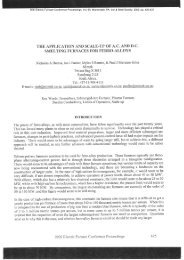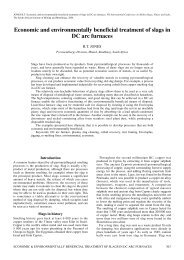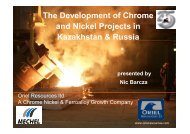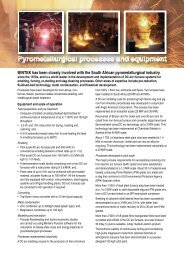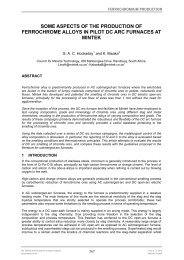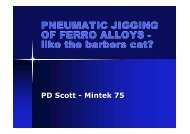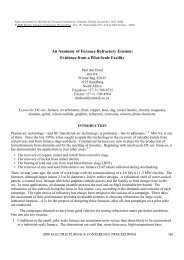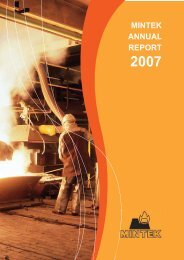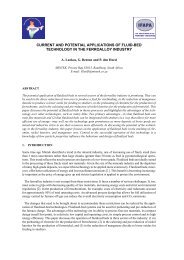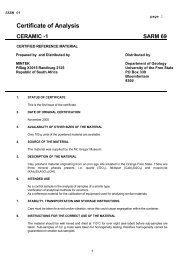<strong>Some</strong> <strong>myths</strong> <strong>about</strong> <strong>DC</strong> <strong>arc</strong> <strong>furnaces</strong>temperature. For example, a value of 0.015 to 0.020 Ωcm istypical for a furnace atmosphere rich in carbon monoxide at atemperature around 1600ºC. Following the approach ofBowman13, the voltage across the <strong>arc</strong> is modelled as afunction of <strong>arc</strong> length and current15. The voltage across theslag is calculated by solving the Laplace equations for theassumed geometry of the slag (with the <strong>arc</strong> depression takeninto account) and an assumed distribution of current at theupper surface16. The slag voltage is directly proportional tothe resistivity of the slag (which is, in turn, a function ofcomposition and temperature). It is important to note that thevoltages across the <strong>arc</strong> and the slag are both nonlinear withcurrent.Figure 12 shows the relationship between voltage (V )and current (I ) for a hypothetical 70 MW furnace operatingwith a fixed slag depth and <strong>arc</strong> length. The constant-powercurve is hyperbolic in shape, resulting from the relationshipP = V I. Constant-resistance lines, resulting from therelationship V = I R, are shown in the diagram in order tocontrast with the calculated shape of the actual relationshipbetween voltage and current. The lowest of the nonline<strong>arc</strong>urves illustrates the behaviour of the <strong>arc</strong> on its own (i.e.equivalent to a slag with zero resistivity), and the other twocurves show the additional voltage resulting from slags ofdifferent resistivities (1 and 2 Ωcm respectively).The design of the power supply for a <strong>DC</strong> <strong>arc</strong> furnaceneeds to take into account possible variations in <strong>arc</strong> length,slag depth, and slag resistivity (which is affected by slagcomposition and temperature). A number of voltage–currentrelationships need to be plotted, taking into account the rangeof variables being designed for, and a suitable operatingwindow can then be specified.The theoretical model introduced above has been usedextensively to improve the understanding of the operation ofpilot-plant <strong>furnaces</strong> at <strong>Mintek</strong>. Further confirmation of thevalidity of the model can be found by noting the goodqualitative agreement between the shape of the theoreticalcurve16 for voltage versus <strong>arc</strong> length, and the recentlypublished measured curve for voltage versus <strong>arc</strong> lengthobtained from an industrial 60 MW furnace producingferrochromium10.Of course, the ultimate question of whether a <strong>DC</strong> <strong>arc</strong>furnace is a constant-resistance device would be answered byplotting voltage versus current (for a fixed set of conditionsFigure 12—The relationship between voltage and current for anindustrial-sized furnace operating at a fixed <strong>arc</strong> length of 50 cm andwith a slag depth of 60 cm (for an <strong>arc</strong> resistivity of 0.0175 Ωcm)including <strong>arc</strong> length, bath depth, composition, andtemperature) for an industrial furnace running from low tohigh current. The publication of such data is eagerly awaited.One should also keep in mind that <strong>DC</strong> <strong>arc</strong> <strong>furnaces</strong> arepowered by thyristor rectifiers, which allow for very fast andautomatic adjustment to short-term variations in furnaceconditions and enable the furnace to be operated at a specificresistance set-point, if this method of control is selected.Myth 7: New technology in AC <strong>furnaces</strong> makes <strong>DC</strong><strong>furnaces</strong> redundantIt is true that, for steelmaking, AC <strong>arc</strong> <strong>furnaces</strong> to melt scrapare enjoying a growing popularity over the <strong>DC</strong> <strong>arc</strong> furnace forsome practical advantages, but the physics has notchanged17. The AC <strong>arc</strong> furnace’s current cannot be kept 100%symmetrical; its power factor is poorer; power on/off isachieved through switching of the furnace transformer; and,while <strong>arc</strong>ing, the AC <strong>arc</strong> furnace always generates moreflicker than a <strong>DC</strong> <strong>arc</strong> furnace. This might not be much of anissue in cases where a) the furnace is not very big and b)where the supplying electrical grid is strong (high shortcircuitcapacity).Neither the steel industry nor the ferroalloy industry istypically located close to a major cosmopolitan hub with20 GW of electrical power generation just nearby. No, thisindustry is often far away from a large power generationplant. Through the long transmission line required to supplythe electrical power to the plant site, the short-circuit capacityof the grid deteriorates over distance, and hence the grid ismore and more prone to disturbance by flicker generated inthe <strong>arc</strong> furnace.As electrical utility companies need to deliver cleanelectrical power to the nearby town or other industrial plants,they often enforce stringent requirements of power quality onall their customers. This means that all flicker and harmoniccurrent that originates from the electric-<strong>arc</strong> operation needsto be ‘cleaned up’ on the plant site. The more stable the <strong>arc</strong>,the less flicker and harmonic current is produced.Additionally, reactive power load swings could cause voltagefluctuation with a magnitude of ± 10% at high voltage level.The furnace’s operation at poor power factor also has anegative impact on power quality. All these phenomena arethe more problematic the weaker the power grid is at couplingto the plant site. They could escalate to a magnitude where itbecomes impossible to operate a large (more than 50 MW)<strong>arc</strong> furnace.However, there are a number of corrective means thatenhance power quality and enable <strong>arc</strong> furnace operation evenon a weak grid (S furnace < 25 x S cc _HV). There is the StaticVar Compensator (SVC), which allows for constant voltagecontrol on the furnace MV-bus with the help of a thyristorcontrolledreactor while keeping the power factor in therequired limit and cancelling the harmonic currents at thesame time18. Should power quality targets still not beachieved, an even more effective tool, the voltage sourceconverter (VSC), is at hand; this (in simple terms) usesadvanced power electronics, an Insulated gate bipolartransistor (IGBT) stack, for keeping the MV voltage constant(flicker mitigation) and enhancing the power quality.▲670 OCTOBER 2011 VOLUME 111 The Journal of The Southern African Institute of Mining and Metallurgy
<strong>Some</strong> <strong>myths</strong> <strong>about</strong> <strong>DC</strong> <strong>arc</strong> <strong>furnaces</strong>100%80%60%40%20%0%AC <strong>arc</strong> furnaceconventional100%AC <strong>arc</strong> furnacewith reactor75%<strong>DC</strong> <strong>arc</strong> furnace50%<strong>DC</strong> <strong>arc</strong> furnacewith SVC25%<strong>DC</strong> <strong>arc</strong> furnacewith VSC and shift-control7%Figure 13—Comparison of power grid disturbance from electric <strong>arc</strong> <strong>furnaces</strong> (flicker level, based on scrap melting)Severity of disturbanceTransactionPaperFigure 14—The norm DIN EN 61000-4-15 specifies how to measure flickerBut, in all cases, a strong improvement in power qualityon the weak grid is achieved through choosing <strong>DC</strong> technologyinstead of AC. The <strong>DC</strong> <strong>arc</strong> furnace operates at a better powerfactor; switching transients from energizing the furnacetransformer can be completely eliminated, and the flickerseen on the MV-bus is approximately half as severe.Only feasible with a <strong>DC</strong> <strong>arc</strong> furnace is a technology called‘shift-control’, also known as ‘split-alpha operation mode’.By controlling the firing angles of a four-rectifier <strong>DC</strong> powersupply according a special algorithm, flicker on the HV-buscan be further reduced by a factor of 1.5 while, at the sametime, also reducing the reactive power and harmonic currentgenerated.What is flicker?Flicker is a non-periodical voltage fluctuation visible to thehuman eye. It is defined and quantified through thefrequency response to sinusoidal voltage fluctuations of acoiled filament gas-filled lamp (60 W, 230/120 V) combinedwith the human visual system. The response function isbased on the perceptibility threshold found at each frequencyby 50% of the persons tested, which results in a weightingcurve with 8.8 Hz found to be most dominant.The units of the flicker are the following:➤ P st _95 (Perturbation Short Term) Interference factorduring 10 min with 95% of the measuredsamples staying within the limit.➤ P lt _98 (Perturbation Long Term) Interference factorduring 2 hours with 98% of the measuredsamples staying within the limit.Flicker is normally measured at the PCC (Point ofCommon Coupling) on High Voltage. A typical limit requestedby the utility is P st _95 = 1.0Audio noiseA further advantage of <strong>DC</strong> <strong>furnaces</strong> when used for scrapmelting is the reduction in audio noise relative to AC<strong>furnaces</strong>.Myth 8: The <strong>DC</strong> reactor in the power circuit causesflashovers/stray <strong>arc</strong>ingNo! The <strong>DC</strong> reactor is basically an energy storage device.<strong>Some</strong> typical values for a ferroalloy <strong>DC</strong> <strong>arc</strong> furnace would beThis is not very much energy, but normally enough tokeep the <strong>arc</strong> reasonably stable. By no means could one‘suddenly’ interrupt an <strong>arc</strong>; that theoretically would result inan infinitely high voltage from the <strong>DC</strong> reactor. Whether it is ascrap cave-in or an electrode breakage, there is alwaysenough time to gradually discharge the energy of the <strong>DC</strong>reactor through the <strong>arc</strong> which is established already, or[7]The Journal of The Southern African Institute of Mining and Metallurgy VOLUME 111 OCTOBER 2011 671▲



